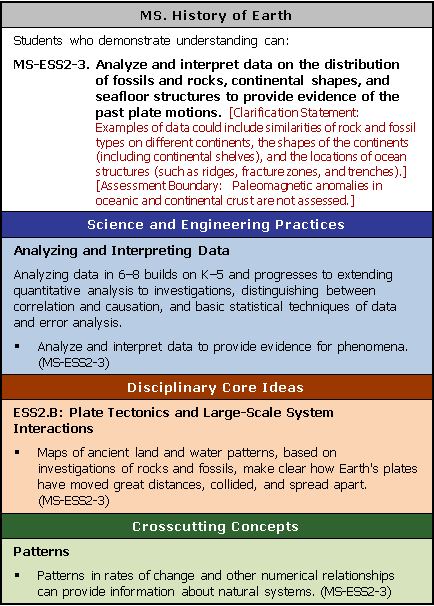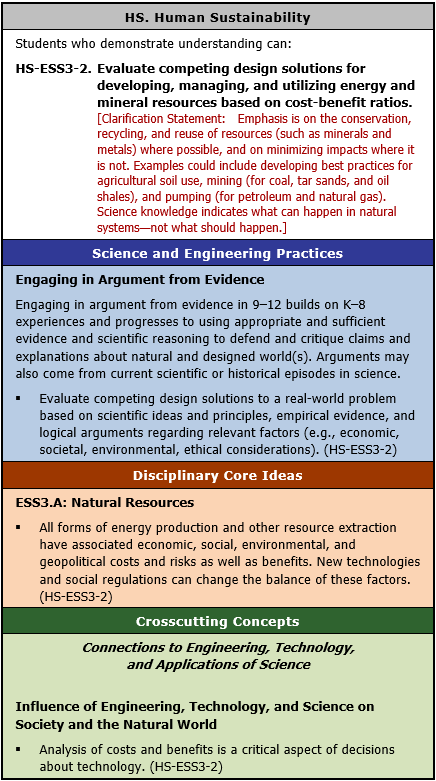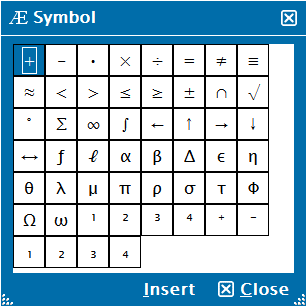Study Guide
Field 162: Earth Science
Recommendation for individuals using a screenreader: please set your punctuation settings to "most."
Review the special character palette available for science CSTs:
Sample Constructed-Response Item 1
Competency 0006
Pedagogical Content Knowledge
Use the following New York State P to 12 Science Learning Standard to complete the assignment below.
Using your pedagogical and content knowledge of Earth science, write a response of approximately 400 to 600 words in which you:
- identify a specific learning goal for the lesson;
- describe how you will assess student readiness for the lesson's learning goal;
- describe an appropriate and effective three-dimensional (i.e., disciplinary core idea, crosscutting concept, science or engineering practice) instructional strategy that you would use to help students meet the learning goal;
- explain how the instructional strategy you described will connect students' prior understanding (e.g., cultural relevancy, real-world experience) to the new knowledge related to the learning goal;
- describe a modification to the instruction that you would use and explain how it would address the strengths and/or needs of all students; and
- describe an appropriate and effective assessment related to the learning goal, in order to evaluate and promote learning and growth for all students.
Learning Standard
You are planning instruction for a middle school Earth science class. The lesson that you are preparing to teach will address the following standard from the New York State P to 12 Science Learning Standards.1

MS. History of Earth
Students who demonstrate understanding can:
MS-ESS2-3. Analyze and interpret data on the distribution of fossils and rocks, continental shapes, and seafloor structures to provide evidence of the past plate motions. [Clarification Statement: Examples of data could include similarities of rock and fossil types on different continents, the shapes of the continents (including continental shelves), and the locations of ocean structures (such as ridges, fracture zones, and trenches).] [Assessment Boundary: Paleomagnetic anomalies in oceanic and continental crust are not assessed.]
Science and Engineering Practices
Analyzing and Interpreting Data
Analyzing data in 6 to 8 builds on K to 5 and progresses to extending quantitative analysis to investigations, distinguishing between correlation and causation, and basic statistical techniques of data and error analysis.
- Analyze and interpret data to provide evidence for phenomena. (MS-ESS2-3)
Disciplinary Core Ideas
ESS2.B: Plate Tectonics and Large-Scale System Interactions
- Maps of ancient land and water patterns, based on investigations of rocks and fossils, make clear how Earth's plates have moved great distances, collided, and spread apart. (MS-ESS2-3)
Crosscutting Concepts
Patterns
- Patterns in rates of change and other numerical relationships can provide information about natural systems. (MS-ESS2-3)
Sample Strong Response to Constructed-Response Item 1
A specific learning goal for the lesson is for students to analyze and interpret data on the distribution of fossils and rocks to support theories of plate tectonics.
Student readiness for the learning goal will be determined by a teacher-led question and answer discussion about previous knowledge of: plate boundaries, geography, continental shape, ocean floor features, the lithosphere, and the asthenosphere.
An instructional strategy that matches this learning goal would be a series of inquiry lab investigations.
The teacher will start by showing students how to use a paleo or paleo-bio fossil database. The students will use the database to discover fossils in New York, including fossils found in their area. This will spark students’ interest in the topic. Selection of a database that maps the fossils will enhance the learning of all students. Once the students have had an opportunity to explore the wealth of information on fossils present in their area, the teacher will provide students with a list of relevant index fossils that will be used throughout the remaining activities. Students will be asked to locate these fossils in New York and then use the database to locate the specific fossils throughout the world. Students will then gather information on these fossils including location; environment of formation; rock formation found in; and fossil age.
Using a map of the world, students will label rock formations. Students will color code cutouts of the fossils based on their environment of formation and the paste the cutouts in their locations. Students will be asked to look at their maps and generate questions about discrepancies that they find, i.e., How did the organism travel from South America to Africa? And Why are there tropical plant species in Antarctica?
Students will be asked to formulate hypotheses that might answer their questions like:
A. terrestrial plants and animals cannot travel large distances across oceans, so continents must have been closer together
B. climate on continents changed over time, so the location of the continents may have changed.
Students will then cut out the continental shapes, and by matching up shape, rock formations and fossil types, will fit the continental together on a circular template to discover Pangea. Students should be able to answer their questions and validate or invalidate their hypotheses. The students' answers and hypotheses will then undergo peer review and the teacher will examine responses.
To enforce the concept that masses of rocks can move, a hands-on instructional modification could be used. Setup a large pan of water and place a series of blocks in it. Then, safely applied heat at the center of the pan and the movement of the blocks is observed. Students can see that the Earth’s tectonic plates (the lithosphere) move over the convection currents occurring in the asthenosphere in the Earth’s mantle. Building on the understanding of earth’s interior structure, the mechanism of plate movement is essential in understanding earth’s ever-changing surface.
As a follow-up investigation, students will use the data on the age of the fossils to determine the rate of the separation at the Mid-Atlantic ridge to further enhance their understanding of how continental positions have change from where they were located in Pangea, to where they are located in the present day.
To assess students’ knowledge, students would be assigned to write an essay related to the learning goal. Their essay will be peer-evaluated based on a rubric generated with the assignment. Students will analyze peer review comments and incorporate into a final essay for the teacher.
Sample Constructed-Response Item 2
Competency 0006
Pedagogical Content Knowledge
Use the following New York State P to 12 Science Learning Standard to complete the assignment below.
Using your pedagogical and content knowledge of Earth science, write a response of approximately 400 to 600 words in which you:
- identify a specific learning goal for the lesson;
- describe how you will assess student readiness for the lesson's learning goal;
- describe an appropriate and effective three-dimensional (i.e., disciplinary core idea, crosscutting concept, science or engineering practice) instructional strategy that you would use to help students meet the learning goal;
- explain how the instructional strategy you described will connect students' prior understanding (e.g., cultural relevancy, real-world experience) to the new knowledge related to the learning goal;
- describe a modification to the instruction that you would use and explain how it would address the strengths and/or needs of all students; and
- describe an appropriate and effective assessment related to the learning goal, in order to evaluate and promote learning and growth for all students.
Learning Standard
You are planning instruction for a high school Earth science class. The lesson that you are preparing to teach will address the following standard from the New York State P to 12 Science Learning Standards.2

HS. Human Sustainability
Students who demonstrate understanding can:
HS-ESS3-2. Evaluate competing design solutions for developing, managing, and utilizing energy and mineral resources based on cost-benefit ratios. [Clarification Statement: Emphasis is on the conservation, recycling, and reuse of resources (such as minerals and metals) where possible, and on minimizing impacts where it is not. Examples could include developing best practices for agricultural soil use, mining (for coal, tar sands, and oil shales), and pumping (for petroleum and natural gas). Science knowledge indicates what can happen in natural systems—not what should happen.]
Science and Engineering Practices
Engaging in Argument from Evidence
Engaging in argument from evidence in 9 to 12 builds on K to 8 experiences and progresses to using appropriate and sufficient evidence and scientific reasoning to defend and critique claims and explanations about natural and designed world(s). Arguments may also come from current scientific or historical episodes in science.
- Evaluate competing design solutions to a real-world problem based on scientific ideas and principles, empirical evidence, and logical arguments regarding relevant factors (e.g., economic, societal, environmental, ethical considerations). (HS-ESS3-2)
Disciplinary Core Ideas
ESS3.A: Natural Resources
- All forms of energy production and other resource extraction have associated economic, social, environmental, and geopolitical costs and risks as well as benefits. New technologies and social regulations can change the balance of these factors. (HS-ESS3-2)
Crosscutting Concepts
Connections to Engineering, Technology, and Applications of Science
Influence of Engineering, Technology, and Science on Society and the Natural World
- Analysis of costs and benefits is a critical aspect of decisions about technology. (HS-ESS3-2)
Sample Strong Response to Constructed-Response Item 2
Goal: Students will compare the pros and cons of various energy resources and determine which resource will both meet their community's future energy needs and minimize their environmental impact.
To see if the students are ready for the lesson, the teacher will:
1. review cost-benefit analysis
2. ask students to describe some of the ways that energy is being used in the classroom right now
3. clarify that electricity is a secondary energy resource
a. it must be produced from some other type of energy
4. ask students to think-pair-share possible sources of primary energy
An instructional strategy that matches this learning goal would be having students perform a series of inquiry lab investigations that focus on engaging in argument from evidence; natural resources; and engineering, technology, and science on society and the natural world.
As the first inquiry activity, students will individually form a hypothesis about where the electricity comes from in their local area. Then the students will research:
1. where their local electricity from
2. explain how the electricity is being generated
a. examine the pros and cons of producing electricity in this way
b. economic, societal, environmental, and ethical considerations
After determining the current mode of energy production, the teacher will challenge students to find a more efficient or cleaner mode of electricity production that fits the local communities' requirements. The students will choose a mode of electricity production and form a research groups to explore the possibility of using this mode in their local area. Then, students will:
1. perform a cost-benefit analysis on their specific energy resource
a. based on
i. data researched for local area
ii. chosen energy source
b. list the pros and cons; the cost, benefits and risks
c. focus on economic, societal, environmental, and ethical considerations
2. present and share their information with their classmates
3. participate in a whole class discussion to evaluate all the possible solutions
4. determine which energy resource best meets the local energy need and still protects the natural environment
This instructional strategy will allow students to use prior knowledge of electricity usage and availability of resources in their local community. At the conclusion of this inquiry lab, students should:
1. have reinforced / refuted their hypotheses about energy usage
2. determine whether these resources are useable on a large scale in their area
3. ultimately be provided with evidence to make informed choices on energy use
Some students may have trouble visualizing the abstract nature of resource usage. One modification to support all students could be in the form of a hands-on activity called “cookie mining”. "Cookie mining" could be used to simulate strip coal mining and the impact of environmental pollution. To perform this modification students will:
1. be given a graph paper map showing a town area, stream, forest, and the mine itself
2. place the cookie on the mine and trace around it (this is the original land purchase) and calculate how much the land is worth
3. mine for chocolate chips using paper clips
a. a stopwatch is used to monitor how long it takes to harvest the chips
b. stray cookie parts are considered pollution and the company has to calculate reclamation costs
This activity shows the students the cost of doing business and the cost of environmental clean-up. This activity helps to reinforce the idea that all energy resources come with some environmental cost.
Each group’s presentation will be assessed using a rubric. Additionally, each student will write a persuasive essay. The essay should:
1. support the opinion they have on which resource is the best option to both meet the community's future energy needs and minimize the environmental impact
2. be based on evidence
Performance Characteristics for a Constructed-Response Item
The following characteristics guide the scoring of the response to a constructed-response item.
| Completeness | The degree to which the response addresses all parts of the assignment |
|---|---|
| Accuracy | The degree to which the response demonstrates the relevant knowledge and skills accurately and effectively |
| Depth of Support | The degree to which the response provides appropriate examples and details that demonstrate sound reasoning |
Score Scale for a Constructed-Response Item
A score will be assigned to the response to a constructed-response item according to the following score scale.
| Score Point | Score Point Description |
|---|---|
| 4 |
The "4" response reflects a thorough command of the relevant knowledge and skills:
|
| 3 |
The "3" response reflects a general command of the relevant knowledge and skills:
|
| 2 |
The "2" response reflects a partial command of the relevant knowledge and skills:
|
| 1 |
The "1" response reflects little or no command of the relevant knowledge and skills:
|
| U | The response is unscorable because it is unrelated to the assigned topic or off task, unreadable, written in a language other than English or contains an insufficient amount of original work to score. |
| B | No response. |
Acknowledgments
1From the New York State Education Department. New York State P–12 Science Learning Standards (2018). Internet. Available from http://www.p12.nysed.gov/ciai/mst/sci/documents/p-12-science-learning-standards.pdf; accessed 23 June 2018.

